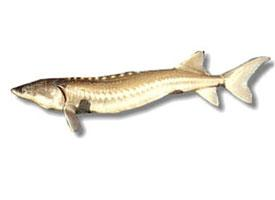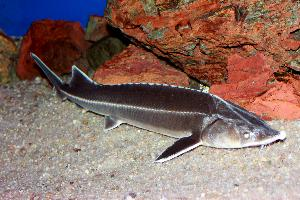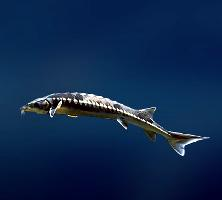
Súlyok és méretek
| Hossz | 610 cm |
|---|---|
| Súly | 680 kg |
Biológiai adatok
| Élettartam | 100 r |
|---|
Állatleírás
The White Sturgeon (Acipenser transmontanus), an ancient and majestic freshwater fish, is one of the largest and longest-lived species within the sturgeon family, a group known for their distinctive morphology and evolutionary lineage that dates back over 250 million years. This remarkable creature is native to the rivers and estuaries along the west coast of North America, ranging from Alaska's Aleutian Islands to the Baja California in Mexico. The species is particularly abundant in the Columbia River and the Sacramento-San Joaquin Delta.Physical Characteristics:
The White Sturgeon is an imposing figure in the water, with a robust, elongated body that can reach lengths of up to 20 feet (6 meters) and weights exceeding 1,500 pounds (680 kilograms), making it the largest freshwater fish in North America. Their bodies are armored with five longitudinal rows of bony plates known as scutes, which provide protection. Their skin is smooth, lacking scales, and ranges in color from gray to olive, with a white underbelly, which is how they derive their name. They possess a heterocercal tail, similar to that of sharks, which aids in their powerful swimming. The White Sturgeon's snout is elongated and tapered, equipped with barbels closer to the mouth which they use to detect prey on the riverbed. Their mouth is ventral, designed to vacuum up their food, consisting of a diet that includes fish, mollusks, and crustaceans.
Habitat and Migration:
The White Sturgeon is an anadromous fish, meaning it migrates from the saltwater environments of the Pacific Ocean into freshwater rivers and estuaries to spawn. However, not all populations migrate; some are known to reside permanently in freshwater habitats. Their preferred environments include large, cold, turbid rivers as well as estuarine areas where they can find ample food and appropriate spawning grounds. The White Sturgeon has shown remarkable adaptability, thriving in both the dynamic estuarine environments and the static conditions of lakes and reservoirs.
Reproduction and Lifespan:
One of the most fascinating aspects of the White Sturgeon is its longevity and slow reproductive rate. These fish can live for over a century, with some individuals reportedly reaching up to 100 years of age. They are also late bloomers in terms of reproduction, with males reaching sexual maturity at around 15 years and females at around 20 years. Spawning occurs in the spring and early summer, with females laying millions of eggs in fast-flowing waters. However, due to their late maturity and specific spawning requirements, their populations are vulnerable to overfishing and habitat disruption.
Conservation Status:
The White Sturgeon is currently listed as a species of least concern by the International Union for Conservation of Nature (IUCN), but its populations are facing increasing pressures from human activities. These pressures include habitat loss due to dam construction, pollution, and the impact of commercial and recreational fishing. Conservation efforts are in place to monitor populations, regulate fishing practices, and restore natural habitats to ensure the survival of this ancient species.
Cultural and Economic Importance:
The White Sturgeon has significant cultural and economic importance. Indigenous peoples of the Pacific Northwest have historically relied on the White Sturgeon as a food source. In more recent times, the species has become a popular target for sport fishing, admired for its size and fighting ability. Additionally, the White Sturgeon is farmed for its roe, which is highly prized as caviar, making it an economically valuable species. However, the challenge remains to balance the economic benefits derived from the White Sturgeon with the need to conserve and protect this remarkable species for future generations.
Hasonló állatok
Új állatfotók
Top 10 állat
- Diana monkey (Cercopithecus diana)
- Dolphin gull (Leucophaeus scoresbii)
- Moustached guenon (Cercopithecus cephus)
- Galápagos tortoise (Geochelone nigra complex)
- Japanese spider crab (Macrocheira kaempferi)
- Colossal squid (Mesonychoteuthis hamiltoni)
- Stone loach (Barbatula barbatula)
- Common house mosquito (Culex pipiens)
- Common reed warbler (Acrocephalus scirpaceus)
- Sea urchins (Echinoidea)

